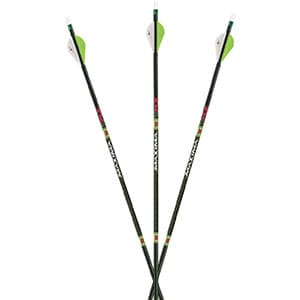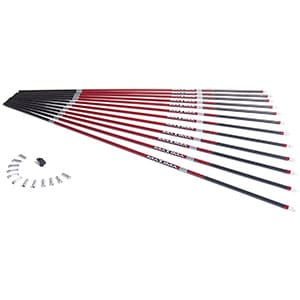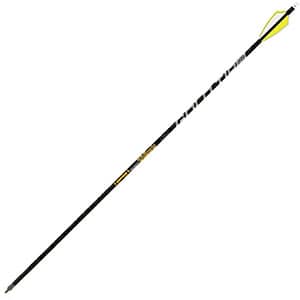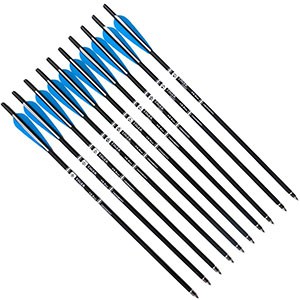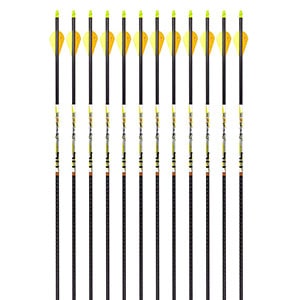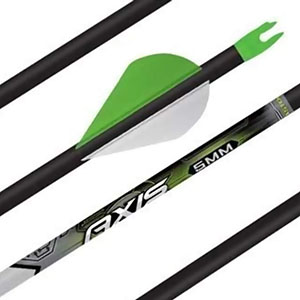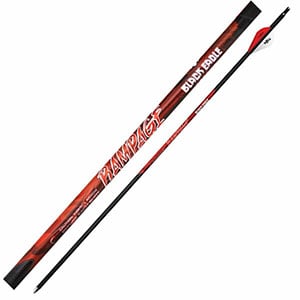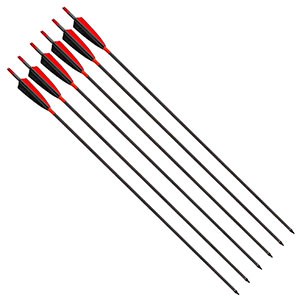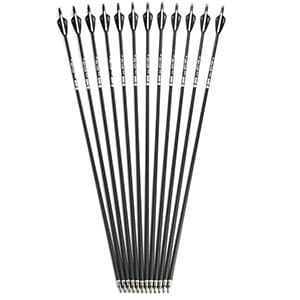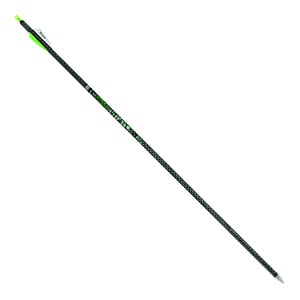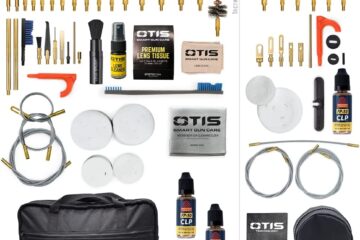The arrows you fire should be able to transfer all the power of your bow to the target. If you choose high-quality arrows that are straight, the right stiffness for their intended use, and the right length to promote safe, effective operation of the bow, they will. Beyond that, you’ll also need to ensure you’re using the right fletching and the right nock to facilitate effective delivery, and the right point to deal with the target.
There are a lot of arrows on the market today. Many seem like incredible deals at first, but if you look a little closer you realize they’re not intended for hunting. So how do you go about finding hunting arrows without spending days sifting through hundreds of irrelevant choices? You start right here, with our list of the best hunting arrows of 2021.
1. Carbon Express Maxima XRZ
If there can be said to be a “big name” in hunting arrows, Carbon Express is as close as they come. Their Maxima XRZ arrows are some of the best of the current generation of lightweight hunting arrows. They’re straight as an arrow (so to speak), feature the company’s Tri-spine Red Zone tech that helps ensure a stable, event-free flight and have Kevlar woven into the fiber to buttress stiffness and strength.
The Carbon Express Maxima XRZ will deliver the broadheads of your choice to the target like a top fuel dragster. Deer, elk, moose, it’s all on the table with the XRZ from Carbon Express. If there’s a downside it’s the price. But in this case it’s very much a matter of getting what you pay for.
2. Carbon Express Maxima Red
Carbon Express isn’t messing around with their Maxima Red hunting arrow. They incorporate everything you want in a hunting arrow in one package. The Red features the company’s patented carbon material that reins in dynamic spine and their vaunted Launchpad precision nock that centers itself on the shaft for more effective transfer of energy from the bow.
The shaft of the Red is laser checked to be within 1/10,000 of an inch of dead straight and is available in only 2 spine levels, 250 and 350. If you want an arrow that will fly straight and true and deliver your broadhead with authority, you’d be hard-pressed to find one better than the Carbon Express Maxima Red. Honestly, it was a tossup between the XRZ and the Red for #1.
3. Gold Tip Valkyrie
The Valkyrie by Gold Tip features lightweight carbon construction, impressive straightness measured to within 6/1000 of an inch and is available in a variety of weights ranging from 5.9 grains per inch (GPI), to 8.8 GPI, which is at the lower end of heavier arrows. The Valkyrie is also a 4 fletched arrow designed to maximize accuracy.
The Valkyrie package arrives with the company’s own well-regarded nocks and inserts, while the arrow itself has been earning praise for its overall toughness and durability. If you don’t have a ton of money to dump into hunting arrows this is a fine choice that will hold its own in the field. Particularly well-suited for deer.
4. Tiger Archery 20 Inch Carbon Crossbow Bolts
Crossbow aficionados looking for a great deal in hunting arrows will find a lot to like with the Tiger Archery 20 inch carbon crossbow bolts. They’re lightweight, stiff, accurate and affordable. They come with the company’s own nocks, fetching and stainless steel field points. Those points aren’t going to do you much good against anything larger than a rabbit, so you may end up swapping them out.
That said, these bolts are 20 inches long with 4 inch plastic fletching and are an outstanding overall value. A pack of 12 works out to just a few bucks per arrow. Just be aware that these are not for traditional bows and not for targeting anything at a significant distance.
5. Carbon Express D-Stroyer
Hard to get away from Carbon Express when we’re talking hunting arrows, and that’s much to the company’s credit. They do what they do and they do it well. The Express D-Stroyer is tough, stiff, consistent, features an outer layer of modulus carbon weave and flies straight and true to the target.
Spine options are 350, 400 and 500, and the arrows come with the company’s proprietary Launchpad Precision Nocks and inserts. (Sorry, but you’ll have to find and install your own fletching.) The shaft is laser-verified to within 3/1000 of an inch to absolute straight. Unfortunately, like most Carbon Express arrows they’re going to set you back a few bucks.
6. Easton Axis Pro Carbon Arrow
The Easton Axis is a relatively thin lightweight carbon arrow that is laser checked to within 1/1000 of an inch for straightness. It comes with the company’s press-fit X Nocks and aluminum inserts. Otherwise these are rough shafts that will need to be cut to your desired length and fitted with your choice of points and fetchings.
Easton doesn’t have the market cache of Carbon Express but these are worthy hunting arrows for the bow hunter who likes to have control over their arrow. Also, they’re heavy arrows that pack quite a punch and will be too much for small game. So keep that in mind.
7. Black Eagle Rampage 350
The Black Eagle Rampage is a stiff, straight, durable, middleweight carbon arrow that’s ideal for deer or elk. The shaft has been verified by laser to be 1/1000 – 3/1000 of an inch off of absolute straight and they come with the company’s own Black Eagle R-Nocks and 18 grain Bohning Blazer Vanes.
The Rampage has a narrow shaft that aids in long-range accuracy, but you’ll need to supply your own tips and cut the arrow to your desired length. The 350 spine only reinforces the notion that this is a long-range projectile. Black Eagle Archery makes some outstanding arrows, but none are particularly cheap. So if you’re looking for a bargain this isn’t it.
8. MS Jumpper Carbon Arrows
If you’re looking for that bargain arrow you might want to consider the MS Jumpper Carbon Arrow. They’re reasonably stiff, very durable, laser-checked to within 5/1000 of an inch to absolute straight and good for indoor practice or outdoor deer hunting.
The Jumpper Carbon Arrows come pre-fletched with 4 inch peltate-shaped feathers (yes, real feathers). They’re compatible with a compound, recurve, traditional or longbow with up to a 65 pounds draw. They come with field tips that are great for target practice but won’t do much other than wound a large mammal, so you’ll need to supply your own broadheads. Overall, though, a great value.
9. Musen Carbon Arrows
Musen Carbon Arrows are compatible with compound bows, recurve bows and long bows, are 28 inches long and feature the company’s own serviceable nocks. If they’re not to your liking though they can be easily replaced, so that’s certainly not a deal killer.
Overall, these are accurate, durable and very budget friendly carbon arrows that you can use at the range with their included field points, and then use in the field with your favorite broadheads. They don’t pack enough punch to take down a bull moose, but for the most part they’ll be just fine for small and medium size game.
10. Victory V-TAC 27
The V-TAC 27 from Victory Archery was designed in consultation with Olympic archers. Its mission is to provide optimal accuracy, in-flight consistency and punch, and we’re happy to say it delivers on all fronts. The V-TAC 27 is straight to within 1/1000 of an inch and is fashioned from the highest quality carbon fiber weave.
Make no mistake, this is a heavy arrow. But you don’t get this kind of accuracy by being a featherweight. And if your goal is to bag a 1,500 lb bull moose the V-TAC 27 is capable of delivering a knockout punch. The V-TAC 27 is expensive too. But there are plenty of hunters who’ll consider it worth it.
FAQs
Hunting with a bow and arrow is the very definition of old school. It can also provide immense satisfaction as it requires a level of patience and skill other forms of hunting can scarcely touch. But you can’t just saunter into the woods with your new bow and start shooting, you need arrows that will perform with your bow, that will bring down your intended target, and that you are used to working with. (Many states also require a special license (1) to hunt with a bow and arrow) The following are things you should consider before purchasing hunting arrows.
What to Look for in a Hunting Arrow
While our ancestors 100,000 years ago didn’t have much to choose from when it came to arrow designs and materials (2), we’re the beneficiaries of progress. However, with progress comes variety and that means buying the right hunting arrow today is not as simple as closing your eyes and pointing. You have quite a few things to consider. Let’s go through them.
The Point
Arrow points have changed a lot since the days when Mammoths lumbered across the plains. Today, points fall into more than half a dozen categories, and there are different styles with each category. The main categories are:
Broadheads – Without a doubt, the broadhead (3) is the most popular type of hunting arrowhead. The broadhead has either fixed or mechanical protrusions that aid in the arrow’s aerodynamics and also ensure the arrow penetrates effectively and stays planted. Expect large wounds and lots of blood.
Blunt points – Blunt points are most often used for small game. The blunt end has several spiky protrusions that do the killing, but the blunt end ensures the arrow doesn’t go through the game and pin it to a branch or tree trunk where you can’t retrieve it.
Bowfishing points – Bowfishing (4) points are designed to slice through the tough scales of carp and similar fish. The protruding barbs snag the fish effectively and make it easy to retrieve. Those barbs are usually retractable to make it easy to remove the fish.
Bullet points – You won’t take down much with these bullet-shaped arrow points. But everybody needs to practice before they venture out, bow in hand, and that’s what these arrow heads are for.
Field points – Despite the name you’re taking a chance if you take these points into the field to hunt with. They’re more likely to wound the animal than take it down, and it will subsequently get away. Like bullet points, field points are mainly for target work.
Grabbing points – Another target oriented point, the grabbing point has a fairly blunt end that isn’t going to do much damage to game. Instead, it has spring loaded grabbing hooks that prevent the arrow from disappearing when fired into the ground.
The Shaft
For most of human history hunters were limited to wooden shafts. That’s not the case anymore. Here are some of today’s most popular shaft materials.
Wood – Before we get into the more modern materials we need to tip our cap to tradition. While not as durable as some other materials they have the weight of history on their side and are still preferred by some hunters for that reason. They’re also affordable.
Aluminum – Aluminum shafts aren’t as sexy as some of today’s other materials, and quality tends to vary, but they tend to be more affordable. You can also cut them down to the length you prefer. A good choice for beginners.
Fiberglass – Fiberglass shafts are among the cheapest you’ll find and archers and hunters tend to have a love/hate relationship with them. On the one hand they’re durable, heavy and consistently straight. On the other hand they don’t have the carry or speed of other materials, which makes them a pretty poor choice for hunting.
Carbon – Carbon fiber (5) shafts are among the most expensive you’ll find. They burst on the scene in the 90s and have since become the most popular type of arrow. While they do cost more they’re also faster, more accurate and produce better penetration than most other arrows.
The Fletching
Fletching refers to the feathers or other ‘wings’ at the end of the arrow that help the arrow fly straight and true. Arrows typically have 3, (or sometimes 4), fletches of various shapes, depending on the action you want from the arrow. As is the case with other parts of the contemporary arrow you have a more than one choice when it comes to fletching these days.
Feathers – The traditional fletching material, feathered fletching is typically produced using feathers from a turkey wing. Feathers are not a favorite of hunters because they become water-logged in the rain which seriously affects accuracy. Feathered fletching is mostly used for indoor archery competitions.
Plastic – There is a plastic version of absolutely everything today so the existence of plastic fletching is no surprise. Plastic actually makes an outstanding fletching material because it’s stiff and waterproof and comes in many shapes and sizes. In fact, it is by far the most popular fletching material in use today.
Alternative materials – Some hunters make their own fletches using materials as diverse as duct tape, balsa wood, leaves, birch bark, rawhide and other materials.
Weight
Weight plays a big part in determining the power and speed of an arrow. A heavier arrow is going to produce deeper penetration than a lighter arrow, and the extra weight is also ensures the arrow delivers enough punch to take down a large target over longer distances. If, on the other hand, you intend to hunt small game like rabbit, a light, fast arrow is the better choice.
Length
There is no such thing as the perfect arrow length. What’s perfect for you may be disastrous for someone else. To determine the perfect length for your purposes you’ll need to keep several things in mind:
- What you intend to use the arrows for.
- Any state laws that regulate how long an arrow can be.
- What length is safe and comfortable for you to use.
If you are a complete beginner and don’t have any idea what length might be right for you there are online charts that will help get you started.
Diameter
Due to the emergence of new materials the typical contemporary arrow is thinner than its historical ancestor. What constitutes the “best” shaft diameter is open to debate, but generally a thicker, heavier arrow will lose some speed to its lighter cousin, but produce better penetration upon impact. That’s good for larger game but may be overkill for small game like rabbits.
Spine or Stiffness
The amount of bend in an arrow has a big impact on accuracy. Bend is also known as the arrow’s “spine”. Different arrows have different amounts of spine depending on the material and their intended use. Arrow spine is denoted by a 3-digit number known as “deflection”. The more deflection, the more bend in the arrow. So an arrow designated as having deflection of 250 is pretty stiff and will not bend as much as an arrow with deflection of 500. In general the heavier the draw weight of the bow, the stiffer the arrow should be. So always be aware of your bow’s draw weight before choosing arrows.
Front of Center
Front of Center or FOC sounds more complicated than it is. All it indicates is the amount of weight concentrated in the front half of the arrow. This topic has produced some heated debate in recent years as some hunters swear that more is better, and others are just as adamant that too much weight up front messes with flight dynamics and accuracy and that front-loading the arrow is just not worth it. As usual the market has taken note of all the buzz and responded. You can now buy stainless steel or brass inserts to attach to the front of your arrow that weigh up to 100 grains (6). As opposed to average inserts that weigh 10 or 20 grains tops.
Choosing Arrows for a Crossbow
When choosing an arrow for your crossbow the most important considerations are total weight, length and the type of nock. Choosing the wrong arrow for your crossbow can lead to serious injury and damage to your crossbow. All crossbow manufacturers indicate the minimum acceptable arrow weight as well as the type of nock you should have on your arrows.
Length
As a general rule crossbow arrows are either 20 or 22 inches in length. It should specify the proper length for your crossbow in the owner’s manual that came with it. Using an arrow that is too short or too long can have a significant impact on the functional dynamics of the crossbow and lead to operator errors that produce serious injuries. If you don’t have an owner’s manual, write an email to the manufacturer requesting information on ideal arrow length.
Total Weight
Not just the weight of the shaft or the point, but the total weight of the arrow including shaft, point, nock and fletching. If the arrow is too light, firing it can damage the crossbow limbs. As is the case with the length, the ideal weight will be indicated in the owner’s manual that comes with your crossbow. Don’t ignore this number. If arrows came with the crossbow use them as a guide, since the manufacturer will have chosen them because they are the proper weight.
The Nock
The nock is the piece that goes over the end of the shaft and has the groove that the bow string fits into. This is where energy from the bow is transferred to the arrow, so the nock must be the right size and shape. Nocks are not a “one size fits all” proposition. What’s required will vary from crossbow to crossbow. So again, use the manufacturer guidelines to select just the right nock for your crossbow.
The Bottom Line
Today’s best hunting arrows are a far cry from what our ancestors had at their disposal. They’re light, tough, durable and extremely effective. Yes, top of the line arrows are fairly expensive, there’s no doubt about that. But you can still find some very attractive deals at more modest price points.
When buying hunting arrows it’s critical that you get ones that are compatible with your bow and that are designed to take down your intended target. You don’t want something too heavy and stiff if you’re bagging rabbits, and you don’t want something that’s light and spineless if you’re tracking elk. So use the information above to help guide your purchases.
